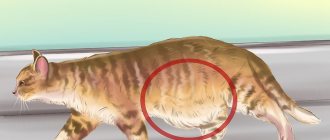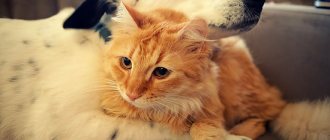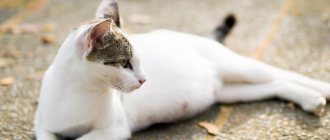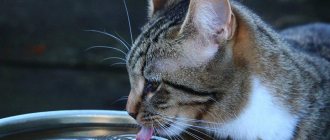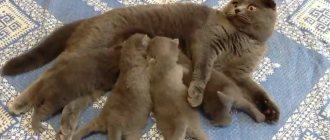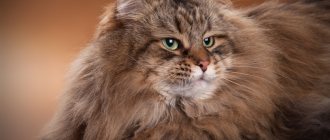Why does a cat sharpen its claws?
The cat sharpens its claws from early childhood. She has this at the level of primary instincts, along with the ability to breathe and suck mother’s milk. It follows that nature has made claws a very important tool in the fight for survival. Therefore, proper and regular attention should be paid to them. Do not ignore the animal’s desire to sharpen its claws. It puts them in order of constant combat readiness, clearing them of exfoliated particles of the claw plate.
Under natural conditions, wood or some other suitable material serves as a sharpening tool. It should not be very hard, but have adequate resistance for the procedure to be effective. If a cat is confined within the four walls of an apartment and does not have the opportunity to walk, it creates a scratching post for itself from scrap materials. Most often this is upholstered furniture.
Polydactyly in cats
We have already mentioned above that there are situations when there are more than 5 fingers on a person’s limbs. This anomaly is called polydactyly. Moreover, for example, the hand may contain both fully developed extra fingers and rudimentary, defective ones.
Polydactyly also occurs in cats, when there are extra fingers on one, two, three, or all four limbs at once (even if the animal has at least one more finger than it should have normally, we can safely talk about polydactyly). By the way, unlike people, who have polyfingered fingers and feet with equal frequency, cats most often have additional fingers only on their front paws.
What are the causes of polydactylism in animals
? It's all about heredity: if either a cat or a female cat has the polydactyly gene, then with a high degree of probability (50%) at least one of their kittens will have extra toes.
How many toes can a cat with polydactyly have?
Usually 6 or 7, rarely 8. Let us remember that additional toes can be present on one foot or on all four. The maximum total number of fingers in a polydactic cat was recorded back in 1974: the animal had as many as 32 fingers instead of the usual 18!
In the old days, if a cat had more fingers than normal, people treated this fact differently:
- Norwegian sailors believed that it was polydacte cats that were much better than ordinary purrs at catching rodents on a ship. In addition, it was believed that such animals promised good luck to everyone on board, and also protected from storms and bad weather;
- In the 1750s in Europe they believed that cats with many toes were accomplices of witches. Often, innocent animals were burned along with sorcerers and witches (many of whom, like cats, were innocent);
- In the USA, for a long time, there has been a belief that stroking a many-toed cat is good luck;
- The 26th President of the United States, Theodore Roosevelt, and the American writer Ernest Hemingway had cats with abnormal limb structure. And the owners doted on their unusual tailed friends.
What to do if your cat has polydactyly
Surely every owner who notices an extra finger on their cat will want to find out whether polydactyly is dangerous.
We hasten to reassure you: in the vast majority of cases, additional fingers do not interfere, and even help the animal:
- Walk comfortably on freshly fallen snow;
- Swim (provided that the pet is not afraid of water);
- Climb up trees;
- Descend from heights and jump
- Successfully catch rodents;
- Open door and window handles;
- And even steal food from the table (although this ability is unlikely to please any owner).
It can be noted that polydactic cats look cute and funny due to their non-standard large paws. But it also happens that accessory fingers cause harm and pain to cats. Improper formation of the toes sometimes leads to the ingrowth of the claw into the soft flesh of the paw. It also happens that the extra toes are too long, so that when walking the animal constantly injures them and cannot fully walk or run.
And in some situations in animals with polydactyly, the joints and bones of the limbs suffer. Therefore, if the anomaly causes inconvenience, it is better to remove additional fingers from kittens at an early age. Or at least you should not be lazy and get advice from a veterinarian on this matter. But still, in most cases, polydactic cats are absolutely healthy pets. And they do not require any treatment.
How to prevent furniture from being damaged by claws?
You should not punish an animal for trying to ruin another chair or sofa. It will not understand and will accept the punishment as an unjustified oppression of its right to freedom. Sharpening claws is a primal instinct. It is better to adapt to it than to regularly traumatize the animal’s psyche. Today there are many scratching posts of original design, made of various materials. They will fit perfectly into any interior, and the cat will be happy to use them without stressing your furniture and nervous system.
A little about ectrodactyly in cats
We talked about polydactyly. Can animals suffer from ectrodactyly? Unfortunately, yes, they can. But fortunately for owners, this disease is very rare in cats. With ectrodactyly, the fingers are smaller than normal and look unusual, and the cat's paw looks like a claw. With this problem, animals experience great problems with motor activity, cannot fully walk and run, climb to heights and land.
And if previously the only way out of the situation was amputation of an abnormally constructed limb, now there is hope for saving the animal from such a radical intervention. In any case, ectrodactyly in dogs in our country has already begun to be corrected surgically, by cutting the front or back paw as correctly as possible so that the animal can move normally.
Should a cat's claws be trimmed?
Cats sharpen their claws not only to remove dead particles, but also to regulate their length. On the street, the claws themselves wear off on the asphalt. If the animal does not go outside, it is better for the owner to periodically trim the overgrown tips of its claws.
You need to trim with a tool specially designed for this purpose. The claws have blood vessels that can be seen by looking at them against sunlight. Only the white tip of the claw is trimmed. This is a rather emotionally traumatic procedure for the animal. It should be taught from a very early age. If trimming the nails for the first time is difficult due to the possibility of injuring the animal, it is better to consult a veterinarian. He will show you how to do this and give recommendations regarding the frequency of cutting nails and caring for the animal after it.
When bringing an animal into your home, you need to learn to take into account the natural needs that it has developed over the centuries. And when you see damaged furniture, you don’t need to start counting how many claws a cat has in order to come up with a punishment for everyone. All you need to do is show a little attention and care. Then your coexistence with your pet will be comfortable, full of love and adoration.
Number of toes on a cat's paws
First, let's find out how many toes cats have on their front paws.
should be normal. Here, mustachioed pets are not much different from their owners: each of their forelimbs usually has 5 fingers, just like people have on their hands.
That is, there are only 10 toes on both front paws. At the same time, the fifth toe on the front leg, which is located higher and further away from the other four, is used by animals mainly for climbing trees and descending from heights; the rest of the time it is inactive
How many toes do cats have on their hind paws
? On the hind legs of cats (kittens, cats - it doesn't matter) there are usually 4 toes, that is, there are 8 toes in total on the hind paws. In total, the average cat has only 18 toes.
How many fingers does a British cat have? British Shorthair: Questions and Answers
Sofia Krasnoselskaya, WCF expert on all breeds of the international category, head of the Sweet Way British Shorthair cattery, answers your questions.
Dear cat owners and kitten buyers! It is important:
- A kitten up to 2-2.5 months should not leave its mother’s house! Buy a kitten from a clean home, with deworming done (that is, when the kitten was given an anthelmintic drug), with vaccinations and documents (veterinary passport and birth certificate or pedigree from the club). Only in this case can you be relatively calm about the health of your pet. The normal age for buying a kitten is 2.5 months or more.
- Before asking your question, look for a similar question and its answer in previous posts.
- All questions about the health of your pets should be directed to the vet. section Remember that sometimes it is very difficult to give an answer about diagnosis and treatment in absentia.
Experts may not answer your questions: - about the health of the kitten, if you took it from its mother prematurely, unvaccinated and without documents; - about how to feed the kitten, how much it should weigh and other questions to which answers have been given repeatedly.
How many fingers do dogs have? Features of the structure of paws, or How many toes do dogs have
For many people, a dog is an equal member of the family that requires care and attention. Once upon a time they were faced with a choice: to have a four-legged friend or not. With the advent of a small pet, all doubts disappear.
Dog breeders are ready to constantly take care of their animal. And the situation related to dogs, which is described in this article, requires special attention. But first, you need to answer the question: how many fingers do dogs really have (including yours)?
How is a dog's paw constructed?
A dog is a digitigrade animal, which means that it is the toes that cope with more load during walking and running than the heels.
A dog's paw has 4 toes. But there are breeds of animals that can have 5 or even 6 fingers. These “extra” fingers are called dewclaws. Most often found on the hind legs, and sometimes on both legs at once. This is due, first of all, to the fact that most breeds of this animal originated from the wolf (huskies, hounds).
Atavism is the appearance of an extra toe on a dog’s paw. It is possible that wolves are also susceptible to this feature, but they are not under supervision, and it is impossible to say for sure about this.
There are as many toes on the hind paws as there are toes on the dog's front paws. Unlike people, they cannot move them, but they still have mobility. Animals walk as if on tiptoes, thanks to which they are able to quickly change the direction of running.
Why does an extra finger appear?
Experts say that the appearance of an extra toe in a dog is a manifestation of atavism. Atavism is a biological process of manifestation in an animal of signs of the class or group whose representatives participated in the breeding of this organism. Over time, these signs lose their functions.
If we talk about how many fingers most dogs should have, then according to the law of biology - 5, perhaps, like their distant genetic ancestor - the wolf. This means that the appearance of an extra finger is a natural pattern.
There is still a debate among experts about why some puppies develop such a toe and others do not. There is an opinion that this is due to the fact that the sign of the appearance of an extra element is a suppressive process. And if you cross a male with five fingers with a female with a normal paw, then the puppies will most likely be born like the father.
You cannot judge its health by how many toes a dog has on its paw. The presence of a “fifth” finger is not considered a pathology; only proper and careful care is required.
Is the fifth finger useful?
If your pet is found to have an extra finger, then there is no need to sound the alarm; this phenomenon is not abnormal or pathological. This feature is acceptable, and in some cases is the norm. Certain dog breeds have a fifth toe, such as hounds, huskies, or Beaucerons. Such an element, so to speak, speaks of purebredness and thoroughbredness.
For dog breeders who are keen on hunting, the presence of a dewclaw in a pet is only an aesthetic problem. During a hunt, a dog has to move much faster than in normal living conditions. In this case, the extra element on the paw interferes with running in tall grass or thickets. A protruding finger clings to grass, mud, snow and twigs in every possible way, making walking difficult.
Should I remove the wolf feature or not?
Surgical removal is performed, the complexity of which depends on how many toes the dogs are considered to have extra, and on how many paws. The procedure is simple and painless. Dogs easily tolerate the operation, which is performed under local anesthesia in half an hour.
It is important to know that surgical removal is not performed on newborn puppies. It’s better to wait until the little dog’s body gets stronger.
This procedure is not necessary for dogs with five toes. Most dog breeders are in no hurry to remove this aesthetic problem, and they are not particularly interested in how many toes a dog has. It is better to remove extra toes on the front paws, as opposed to the hind paws, because they fit tightly to the skin and interfere with walking.
There are cases when dogs refused to move at all, and the whole problem was that fingers with untrimmed claws interfered with running and caused pain.
Hygiene issues
Paws require special care, no matter how many toes a dog has. Hygiene issues become important when dogs live in the same premises as their owners. The animal must be walked twice a day in all weather conditions, which include bacteria, dirt and dust.
Dirt, dust and small particles can be absorbed into the skin and harm the pet's health. This means that it is not enough to simply wipe the dog’s paws with a dry cloth; a thorough wash is necessary.
Only proper and regular care will ensure good health for your pet.
